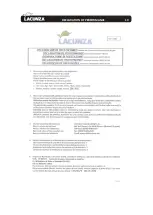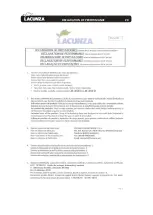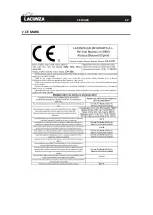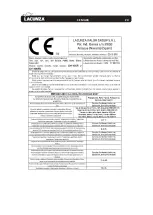
INSTRUCTIONS FOR THE INSTALLER
9
2.
so that when overlapping those hot air
extraction holes are not closed.
2.3.6.
Connection to the flue
The appliance must be connected to the
chimney flue using special piping designed
to resist the products of combustion (e.g.
stainless steel, enamelled steel, etc.).
To connect the flue to the socket flange,
insert the piping inside the flange and seal
the joint with fire sealant or fire cement to
make it completely airtight.
The installer must ensure that the pipe
connected to the appliance is well secured
and there is no chance of it coming free
from its housing (e.g. as a result of
dilatation due to temperature, etc.).
On this appliance, the flue socket can be
fitted either on top or at the rear of the
appliance.
2.4.
Chimney flue
The chimney flue must comply with
present standards on the installation of
chimneys.
In rooms equipped with Controlled
Mechanical Ventilation, the ventilation
outlet must never be connected to the
flue.
The appliance must always have its own
chimney flue, never sharing a chimney flue
with another appliance.
2.4.1.
Type of flue
The flue must be made of special
material designed to resist the products of
combustion (e.g. stainless steel, enamelled
steel, etc.).
Non-central-heating
appliances
(without back boiler) require an insulated,
double-sleeve flue only on those sections
that run outdoors or through cold areas.
Single piping can be used inside the
building, the heat of the gases serving to
heat rooms, insulating only those sections
where excess temperature may cause
damage.
If the chimney is constructed, then it is
necessary to pipe and insulate it to ensure
correct updraught.
The diameter of the pipe must be the
same as the diameter of the flue socket on
the appliance over its entire length in order
to ensure correct operation.
The flue must prevent the entry of
rainwater.
The flue must be clean and airtight over
its entire length.
The flue must be at least 6m tall and the
chimney cap must not hinder the free
release of gases.
If the flue tends to suffer from
downdraught, then it is necessary to fit an
effective anti-downdraught cowl, a static
cowl or a smoke extraction fan, or reshape
the chimney.
Never make 90º bends, due to the great
loss of draught they cause, and reduce 45º
bends down to an absolute minimum. Each
45º bend is equivalent to a 0.5m reduction
in flue length. Horizontal flue sections
should not be installed because they cut
updraught a great deal.
If the flue draws at more than 20 Pa on
12Pa, then an effective damper must be
fitted on the flueway. This damper must be
visible and accessible.
The chimney flue must not rest on the
appliance.
Bear in mind that high temperatures
may be reached in the flue, meaning that it
is essential that insulation be enhanced in
sections in which combustible material is
present (wooden beams, furniture, etc.). It
may even be necessary to protect non-
combustible material in order to prevent
breakage, deformation, etc., as a result of
Summary of Contents for CM-300
Page 1: ...CM 300 CM 300 FD CM 300 FI CM 300 R Instruction Book ...
Page 19: ...DECLARATION OF PERFORMANCE 18 6 DECLARATION OF PERFORMANCE ...
Page 20: ...DECLARATION OF PERFORMANCE 19 6 ...
Page 21: ...DECLARATION OF PERFORMANCE 20 6 ...
Page 22: ...DECLARATION OF PERFORMANCE 21 6 ...
Page 23: ...CE MARK 22 7 CE MARK ...
Page 24: ...CE MARK 23 7 ...
Page 25: ...CE MARK 24 7 ...
Page 26: ......
Page 27: ......











































